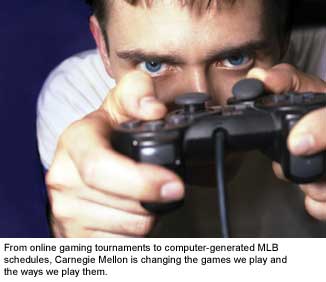So the Trojans of Southern California won the Division I-A national football title this season.
So what? We trounced them in online gaming.

In February, students from the Entertainment Technology Center whipped their USC counterparts in five different games, none related to traditional sports. While the contest went largely unnoticed, it’s one more sign of a sweeping change in the games we play, based on the advance of technology.
For years, kinesiologists have used technology to improve the performance of modern athletes in virtually every physical game that’s played today. Scientific principles are used to build better training techniques and better equipment. With every new season, technology enhances the way we watch sports, even allowing us to “participate” from our armchairs.
Now statistical analysts are turning baseball upside down by studying the statistics of athletes rather than the speed of their fastball. The Boston Red Sox restructured their bullpen based on the statistical findings of baseball guru Bill James. Other baseball teams are turning to exhaustive quantitative methodologies to find new talent, sifting through the stats of thousands of players in high schools and colleges, and analyzing the hundreds of thousands of at-bats and pitches thrown in any given season.
The NBA’s Dallas Mavericks use a statistics-based player-rating system. College and pro football began using computers decades ago to determine the play selection “tendencies” of opposing teams based on what they’ve historically done in specific situations.
Even scheduling has had a makeover. Major League Baseball turned to Carnegie Mellon business professor Mike Trick to manage its stupendously complicated game schedule.

Technology is not only changing the games we know. It’s the foundation for games in the future. Take, for example, the work of Pamela Jennings.
She’s a professor in the College of Fine Arts at Carnegie Mellon who has come up with a high-tech game called Constructed Narratives.
Essentially, it’s a large-scale game of blocks with words instead of letters. Before playing, participants enter descriptive information about themselves into a computer. They then arrange the blocks in space. Sensors transmit the blocks’ location back to the computer, which models the physical construction on a computer screen.
Then proprietary software searches an online English-language lexicon for words about each individual based on how they’ve connected the blocks. The words appear on the blocks on the screen to form a type of narrative, or “high-tech magnetic poetry.” Participants can reposition blocks to change the words in their narrative.
“I like to think of the experience as a group of builders who are collaboratively constructing a world where they are the very material of which the world is made,” Jennings said.
The game resulted from a collaboration of students from nine disciplines: Art, Design, Computer Science, Human-Computer Interaction, Electrical and Computer Engineering, Cognitive Science, Drama, Entertainment Technology and Information Systems Management.



